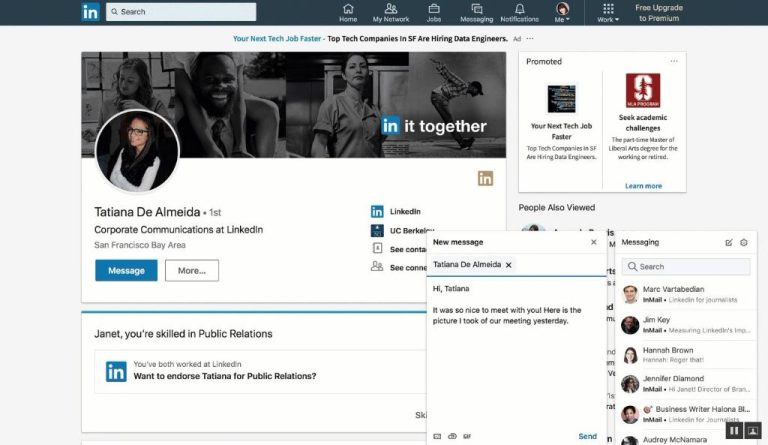Sending attachments with LinkedIn InMail messages can be a useful way to share documents, images, presentations, and other files with your professional network. However, LinkedIn does place some restrictions on attaching files to InMail messages in order to prevent abuse. This article will provide a quick overview of how attachments work with LinkedIn InMail and the requirements you need to follow.
What is LinkedIn InMail?
LinkedIn InMail is the internal messaging system within LinkedIn that allows you to contact other members directly. InMail works similarly to email, but the messages can only be sent and received between LinkedIn members.
Some key things to know about LinkedIn InMail:
– InMail messages go to the LinkedIn member’s inbox, separate from their regular email.
– You can only send a limited number of InMail messages per month depending on your LinkedIn account type.
– InMail provides read receipts so you can see if your message has been read.
– InMail messages must adhere to LinkedIn’s professional community policies.
Can You Attach Files to LinkedIn InMail?
Yes, you can attach files to LinkedIn InMail messages. When composing an InMail, there is an attachment icon that allows you to select files from your computer to attach.
However, there are restrictions on the type and size of files that can be attached. LinkedIn has these limits in place to prevent InMail abuse and protect their members.
Accepted File Types
The only file types that can be attached to LinkedIn InMail are:
– PDF
– DOC/DOCX
– PPT/PPTX
– XLS/XLSX
– JPG
– GIF
– PNG
– BMP
LinkedIn does not allow you to attach executable files (.exe) or other file types that could pose security risks if opened by recipients.
Maximum File Size
The maximum file size for each individual attachment is 25 MB. You can attach multiple files to a single InMail, but each file cannot exceed 25 MB.
If you try to attach a file larger than 25 MB, you will receive an error message and will need to reduce the file size before attaching.
How to Attach Files to LinkedIn InMail
Attaching a file to a LinkedIn InMail message only takes a few simple steps:
1. Click the “Compose InMail” button to start a new InMail message.
2. Address the InMail to the desired recipient(s).
3. Write your InMail message text as normal.
4. Click the paperclip attachment icon in the message composition toolbar.
5. In the attachment window, click “Attach File” and select the file you want to attach from your computer.
6. Once the file is selected, click “Attach” to attach it to the InMail.
7. Repeat steps 4-6 to attach additional files if needed.
8. When ready, click “Send” to send the InMail with attachments.
The attached files will display as clickable links in the recipient’s inbox and in the message thread. They simply need to click the file name to download and open it.
Tips for Attaching Files to LinkedIn InMail
Here are some tips to follow when attaching files to LinkedIn InMail:
– Double check that your files are in an accepted file type and under 25 MB before attaching. This avoids errors.
– Let recipients know in your message text that you have attached files so they are expecting them.
– Be selective about which files you attach – only attach those directly relevant to your message.
– Attachments can be a good way to share presentations, documents, or visual samples of your work.
– Don’t attach unnecessary files or use attachments to get around LinkedIn’s messaging restrictions.
– For large file transfers, it may be better to provide a download link rather than attaching the file directly.
– Make sure your file names are clear and descriptive for recipients.
– Remind recipients not to open unexpected attachments for security purposes.
Limitations of Sending Attachments via InMail
While you can attach files to LinkedIn InMail, there are some limitations to be aware of:
– Recipients may overlook or not notice the attachments.
– Attachments only work between mutual connections. You can’t attach files when messaging non-connections.
– There are tighter restrictions than regular email attachments to prevent abuse.
– You can’t attach dynamic files like databases, web pages, or scripts – only static document files.
– Attachments count toward your monthly InMail allowance. Messages with attachments use up InMails faster.
– There is no tracking or confirmation when recipients download attachments.
– InMail only keeps attachments active for a limited time, not permanently.
Alternatives to Sending Attachments
Due to the limitations, sometimes it may be better to share files with your LinkedIn connections outside of InMail attachments:
– Send a download link – Provide a link where recipients can download files from a cloud storage service or your website. This avoids size restrictions.
– Share via Google Drive or Dropbox – Store files in a shared cloud folder that recipients can access without attachments.
– Use LinkedIn messaging – For smaller files under 10 MB, you can attach and send via regular LinkedIn messages.
– Post files on your LinkedIn profile – Upload presentations, PDFs, and documents to your LinkedIn profile for public sharing.
– Request a meeting – For large file transfers, explain the need in an InMail and request a real meeting to share files in person.
Conclusion
LinkedIn does allow you to attach files to InMail messages in order to share documents and other materials with your professional connections. However, there are restrictions on file types and size that you need to keep in mind. For larger file transfers or dynamic content, it may be better to use an alternative method like shared cloud links. When used selectively for relevant static files under 25 MB, attaching files to InMails can be an effective way to share professional content on LinkedIn.


